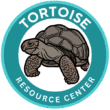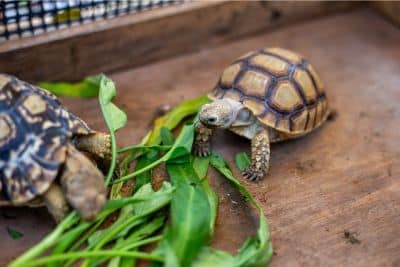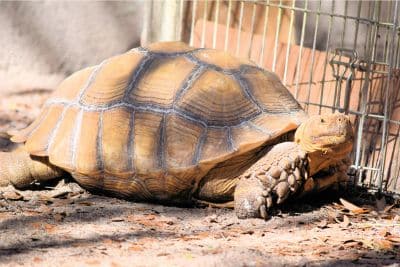All aspects of your tortoise’s enclosure will affect your pet’s health and well-being.
For example, the lighting you use will influence his mood, behavior, and metabolism, while the enclosure top and walls will play a role in his safety. But it is the things on the ground – namely, the bedding and enrichment items included – that will likely influence his daily life most, as he’ll directly interact with these items every day.
Accordingly, it is important that you select a suitable bedding and provide your pet with appropriate enrichment items. In this article, I’ll be helping you to do exactly that, by sharing some of the best options and outlining some of the things you’ll want to consider when making your choices.
Tortoise Bedding Considerations
There are a variety of potential bedding types you can use in your pet’s enclosure, but no single option is best for every situation. Each kind of substrate offers a different combination of benefits and drawbacks, and different keepers will prioritize different things when choosing between these options.
However, all keepers should consider the following factors when trying to select good tortoise bedding:
- Your tortoise may consume the substrate. Tortoises occasionally eat small amounts of substrate, either by accident or because they’re trying to address mineral deficiencies. Accordingly, I recommend using substrates that are neither toxic nor likely to cause intestinal obstructions.
- Substrates vary in cost. While some keepers have access to suitable substrate on their property (thereby making it more-or-less free), most keepers will have to purchase substrate. So, you may need to factor in the cost of your chosen ground cover before you choose what tortoise to keep. This is especially true of those with large tortoise enclosures, as they’ll require a significant amount of bedding material.
- You’ll need to replace the substrate periodically. Most substrates will break down over time and require replacement. This not only means you’ll have to account for the costs associated with purchasing a new substrate, but you’ll also have to factor in the labor necessary to replace old substrate and replace it with new bedding material. This is much easier with some bedding materials than others.
- Many tortoises benefit from having bedding that’ll support burrow formation. Most tortoises will dig burrows in the wild, which they use to help thermoregulate and remain safe from predators. Ideally, you’ll provide your tortoise with a bedding material that’ll support burrow formation, so that your pet can exhibit natural behaviors and feel most comfortable.
- You may want to grow live plants in your pet’s enclosure. Live plants offer a wealth of benefits for captive tortoises, from helping to raise the humidity level in the enclosure to increasing the complexity of the habitat. And while you can simply place potted plants inside the enclosure, some keepers like to install the plants directly in the substrate. This means you’ll need to select a bedding that can support your chosen plants and may not be suitable for indoor tortoise tables.
- The bedding will affect the enclosure humidity. Many tortoise beddings will absorb moisture, which they’ll then release into the air over time. This can be helpful or counterproductive, depending on the needs of your specific pet. So, select bedding that retains a great deal of moisture if your pet hails from humid environments or a bedding that does not retain much moisture if you care for a tortoise from an arid region.
- Bedding can create dust or cleanliness concerns. All substrates present some cleanliness issues. But some substrates (especially those containing lots of small particles, such as some soils and sand mixtures) produce a great deal of dust, which can be especially problematic for keepers maintaining their pet indoors. Similarly, some beddings tend to get caught in door tracks or spill out onto the floor.
- You may find some beddings more aesthetically pleasing than others. Although your aesthetic desires should take a backseat to your tortoise’s needs, they are still something you should consider. There are no right or wrong answers in this regard, but different keepers often prefer the way a particular substrate looks.
The Best Types of Tortoise Bedding
There are a variety of different substrates that’ll work for tortoise enclosures, but it is always important to consider your pet’s specific needs as well as your own desires. Some of the choices that have proven most effective in my opinion include:
- Soil: Soil is one of the most popular substrates for tortoises, as it is affordable, relatively safe if ingested (assuming the soil is free from amendments), and supports the formation of burrows. Soil will also absorb and release moisture over time. However, it is one of the messier options, and it will tend to stick to your pet’s body and shell.
- Cypress Mulch: Cypress mulch also helps maintain a high enclosure humidity, looks good, and it won’t stick to your tortoise’s shell the same way soil will. However, cypress mulch is more likely to cause dangerous impactions if swallowed, and it won’t support the formation of burrows.
- Fir Bark: Fir bark presents most of the same benefits and drawbacks that cypress mulch does. It is often more expensive than cypress mulch, but many keepers find that it is more attractive. Additionally, it is usually processed into rounder pieces than cypress mulch, which makes it easier to handle.
- Custom Soil-Sand Mixtures: Custom soil-sand mixtures are useful for tortoises who need a drier environment than soil-only bedding provides. However, the more sand is included in the mixture, the less likely the bedding will be able to support burrow formation.
- Live Grass or Groundcover: Often the preferred option for keepers who maintain their tortoise outdoors, a natural substrate covered in live grass, weeds, or clover is an excellent option. This combination of natural soil and small plant roots is also helpful for burrow formation. And, of course, your pet can nibble on the living plant material, which provides enrichment value.
- Coconut Fiber: Coconut fiber is often sold in compressed bricks, which will expand when broken up. Coconut fiber absorbs water and can allow for burrow formation if packed down firmly, but it can also present an impaction risk, if your pet consumes much of it.
- Newspaper: Newspaper is essentially free and easy to replace, but it doesn’t provide good traction or the chance for your pet to construct burrows. It also breaks down easily once wet. Accordingly, it is not suitable for long-term maintenance. Nevertheless, newspaper is the substrate of choice for short-term, “quarantine” enclosures.
Enclosure Enrichment: Creating Complexity
In addition to your pet’s bedding, you’ll also want to include items in your pet’s enclosure that provide enrichment. These types of items will help increase the complexity of the habitat and give your pet things to explore – both of which will help ensure your pet lives a happy, full life.
Some of the best tortoise tank setup for enclosure enrichment include:
- Live Plants: Live, non-toxic plants are some of the best things to add to your pet’s enclosure, given the myriad benefits they provide. In addition to the fact that live plants can help increase the enclosure humidity level, they also provide visual barriers and give your pet something else to explore. Of course, your pet may nibble on the plants, which speaks to the importance of selecting tortoise-friendly plants to consume.
- Commercial Enclosure Decorations: There are a variety of commercially manufactured reptile habitat decorations that can help provide more enrichment for your pet. This includes things like faux skulls and artificial logs, among other items. Just be sure to avoid synthetic plants, as your pet may consume them, which can lead to serious health problems.
- Natural Wood Pieces: Driftwood, grapevine, logs, and branches can all provide your tortoise with things to investigate, climb, and explore. Just be sure that you clean any wood items with plenty of hot water and a stiff wire brush before adding them to the enclosure.
- Rocks and Stones: Rocks and stones work well in tortoise enclosures and they’re often available for free (or nearly so). Additionally, rocks are easy to clean before adding them to the enclosure – you can usually just hose them off. However, be sure that any rocks placed in the enclosure are set directly on the floor of the habitat, rather than on top of the substrate. This will help prevent the rocks from crushing your pet, should he try to burrow beneath them.
- Hide Boxes: Hide boxes should be considered mandatory for every tortoise enclosure, as your pet needs to have somewhere to hide and feel secure. In addition, they do also provide enrichment and give your tortoise something else to investigate and explore.
Citations
- Star Tortoise Garden – Indoor Substrates
- Tortoise Trust – Understanding Vivarium Substrates
- Big & Small Tortoise Rescue & Sanctuary — Substrates


